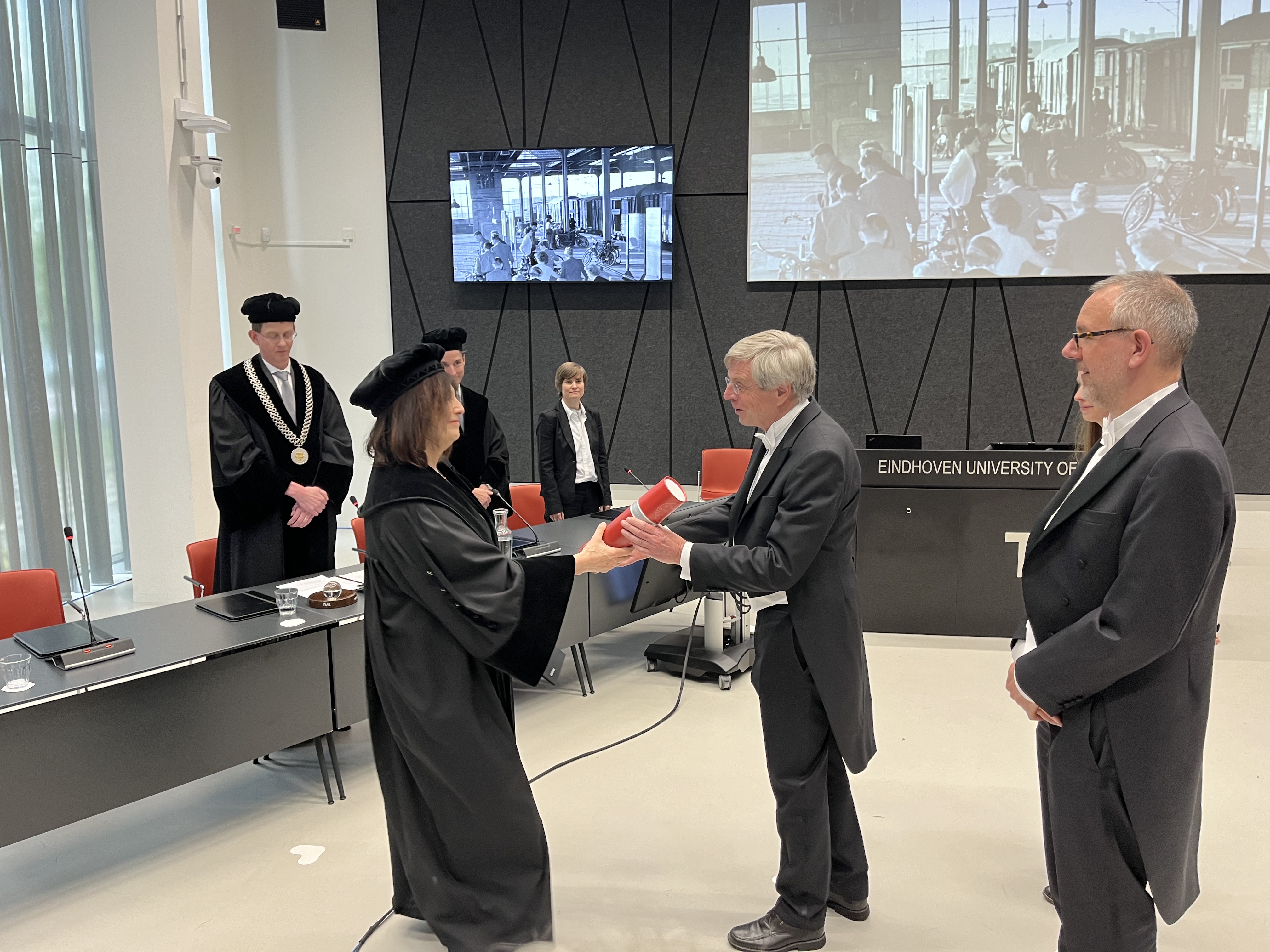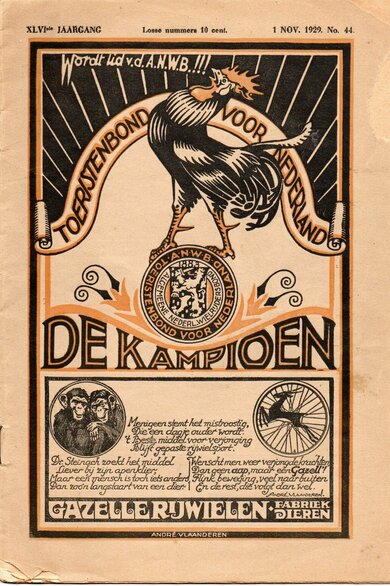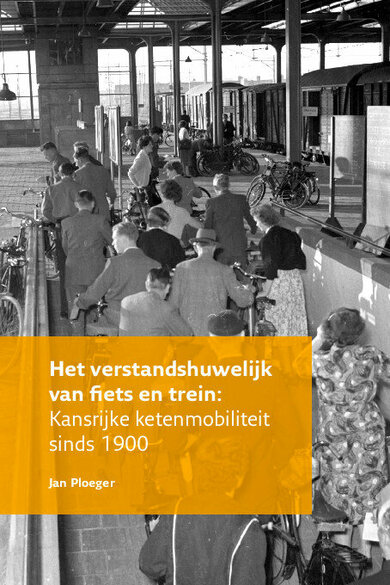
A happy coincidence of circumstances and perseverance. That typifies both the realization of 70-year-old Jan Ploeger’s doctoral research and the subject: the intellectual marriage of bicycle and train. It shows why this is a unique success, how it came about and what we can learn from it in the battle against increasing car traffic. Ploeger received his doctorate from the department of Industrial Engineering & Innovation Sciences on April 18. “We invest millions in technological dreams of the future like the hyperloop, but we take the ingenious success of the bicycle for granted.”
As an engineer in Civil Engineering & Transport Planning, Jan Ploeger spent decades compiling an archive on the assimilation of the bicycle as a Dutch means of transportation. Meanwhile, his supervisor Ruth Oldenziel, full professor in engineering history, had been looking for some time for suitable PhD students to research the success of bicycle use in the Netherlands. The two met at a cycling conference and the match was quickly made.
Snowball effect
A special part of Ploeger’s archive is a historical copy of the ANWB member magazine Kampioen from 1929. Jan Ploeger once found it in his attic. “That copy belonged to my parents-in-law. We never throw anything away.” The article in it titled ‘Refusing bicycles as railroad luggage is possible’ immediately caught his attention. “It was an initial idea for a rental bike, what we now know as the OV-Fiets. The bicycle-train combination theme had fascinated me for some time, especially from a social engagement perspective. So the fact that it was apparently already being considered at that time made me even more curious. That led to a snowball effect.”
System leap
“After all, why do we consider the bicycle a ‘simple’ means of transportation, when it is actually a progressive invention with numerous advantages”, Ploeger thought. “It’s a good example of a system leap. The bicycle is not an extension of the cart, the means of transportation with wheels that preceded it. All the elements were inventive: the chain, spoke wheels, ball bearings, rubber tire, you name it.”
“All those things didn’t exist yet. They were different innovative features that came together at great intervals. And later the automobile benefited from that. A lot of technology for the car came straight from the bicycle. So in that sense, the bicycle is indeed high-tech.”
PhD after all
Ploeger immersed himself more and more in the subject. In this way he unintentionally anticipated the doctoral research he had once postponed as an alumnus of Delft University of Technology. In 1994, at the insistence of his then boss, he had declined the invitation to pursue a doctorate.
“He was a proponent of the way they did it in France at the time: first build up knowledge and skills in the field, then you can always go back.” But as it goes: his career took off and the doctorate got further and further out of sight.

Jan Ploeger receives his PhD degree from promotor Ruth Oldenziel.
Collecting frenzy
Meanwhile, he did continue to collect information about his beloved bicycle. “For example, I have been a member of the Fietsersbond for fifty years and kept all its magazines”, he said. That ‘never throwing anything away’ produced an impressive analog archive, which proved essential for the dissertation he wrote as a retiree: Het verstandshuwelijk van fiets en trein: kansrijke ketenmobiliteit sinds 1900.
Intriguing was the principle of the Netherlands’ successful connection of public transport to cycling. In this regard, the success of the OV Fiets is the feat that other countries envy. “By car, you drive from door to door. How can you realize that same convenience with the combination between bicycle and train? Politicians and scientists worldwide are increasingly asking that question. They want to reduce the number of cars in urban areas. For the answer, cycling country the Netherlands comes into the picture”, Ploeger explains.

Gray literature
But what factors played a role in the development of that cycling country? Ploeger delved into that. “Then my personal archive came in handy; I could build on that nicely. Because there turned out to be a lot of information, but mostly hidden in gray literature. So I had to dig deep. To begin with, I conducted in-depth interviews with key people from the 1960s-1990s to find direction in the research. Then I found a lot in my own archives as well as in the huge NS archive and some other archives.”
All that old-school digging led to a meticulous description of the subject of Ploeger’s research: the emergence of informal chain mobility from the perspective of cyclists. In particular, it shows how big an influence cyclist organizations had on the development of good bicycle parking and rental facilities at Dutch train stations. “That lobby has existed in the Netherlands since 1900. Cyclists discovered how convenient it was to combine bike and train and wanted to facilitate that better. In doing so, they engaged the unions, first through the ANWB, then came the Fietsersbond.”
Turning away from the class struggle
According to him, that support has always held up well in the Netherlands. “Until the mid-20th century, cycling was also widely practiced in neighboring countries, such as Germany. But when the auto industry emerged there, you were quickly called a loser if you didn’t own a Mercedes or Volkswagen. They called that Hosenklammer syndrome, referring to the metal clips that kept your pant legs out of the bicycle chain. The same idea played out in Britain: there the working class rode bicycles and the well-to-do had a car.”
This class struggle between bicycle and car was wasted on the Calvinistic Dutch people. “Just act normal, you’ll be crazy enough. That proverb typifies the Dutch mentality”, Ploeger clarifies.
Scare
In addition, the Netherlands distanced itself from yet another trend in other countries: expanding urban development by American example, with large shopping malls outside cities. “The images of increasing car traffic, long traffic jams and immense parking lots were a scare. Nobody in the Netherlands wanted cities with empty hearts, the so-called donut cities. So cyclists benefited from our spatial order policy that since 1958 has focused on keeping cities compact and encouraging housing development near stations.”
However, the Netherlands still had the fewest cars compared to other European countries at the time, Ploeger said. “That surprised me too. We apparently had the right foresight.” Another remarkable conclusion Ploeger draws from his research is that railroad company NS came into the picture relatively late in the successful marriage of bicycle and train.
“Only in the late 1960s, when they were suffering losses, did they discover the preferences of travelers. Before that, they had never really looked into it, because there was no need. But when the car also became a major competitor in the Netherlands, NS lost more and more customers. So from now on the company received structural state support.”
Possible new era
Since car traffic has been increasing in the Netherlands since then anyway, Ploeger says it is even more important to value the bicycle+train combination. “We are building more and more roads for those busiest two hours a day during rush hour. Perhaps now, in 2024, we should go back to the drawing board and make other choices with the foresight of 1958. The creation of the OV Fiets is therefore not only the conclusion of my dissertation, but also of a long and difficult history and the beginning of a possible new era in chain mobility.”

“Another great example of how new technologies strengthen each other: better materials and components make the OV Fiets more robust, digital payment options ensure that renting the bike nowadays takes three seconds instead of ten minutes. We may well call that a technical revolution.”
Interaction with students
A revolution in which old and new knowledge come together, just like during Ploeger’s doctoral research. “I greatly enjoyed the interaction with young students at TU/e. We helped each other with tips and good ideas and in this way we were always able to take each other further. Retirement is not boring at all”, he concludes with a smile.

